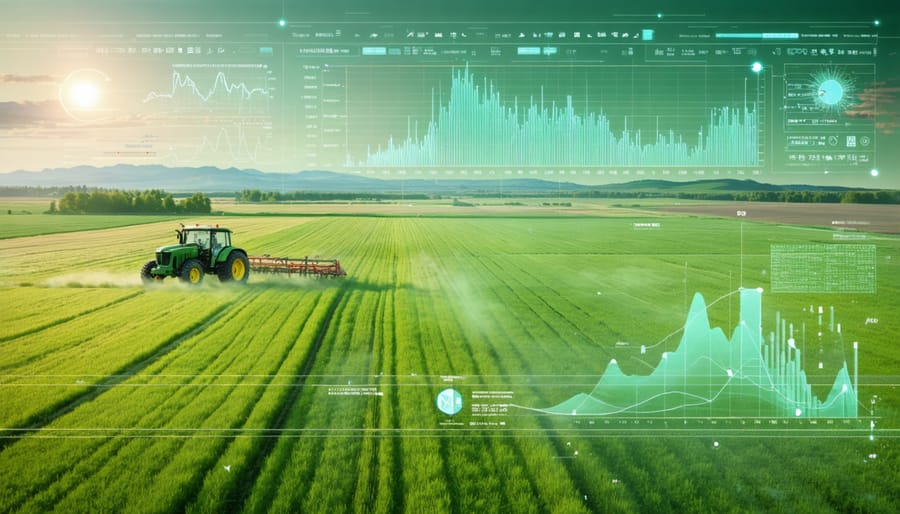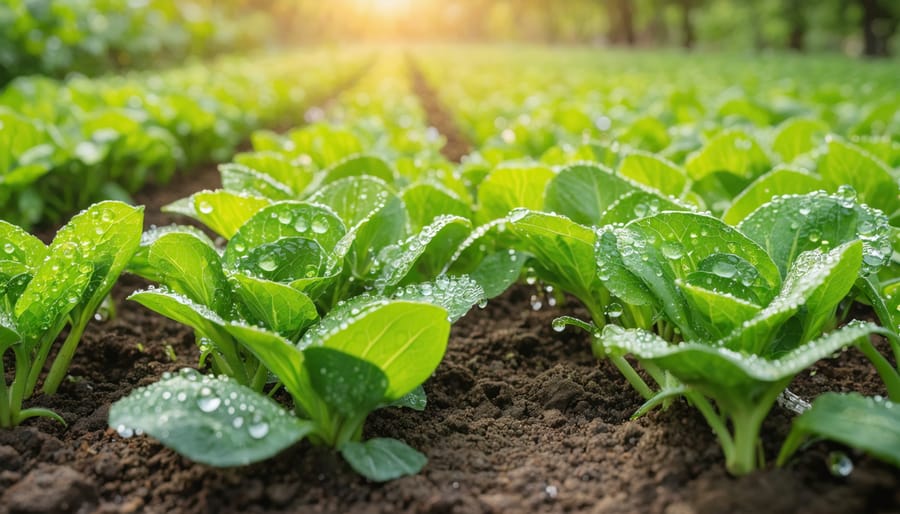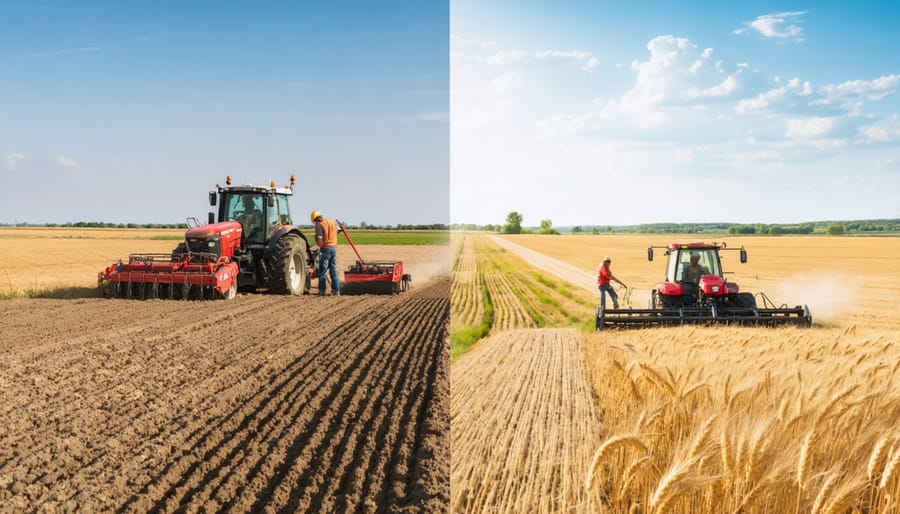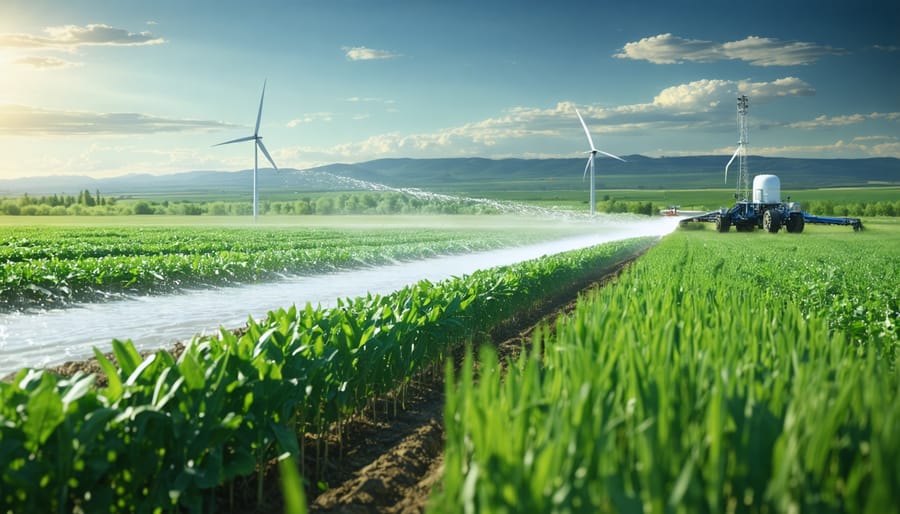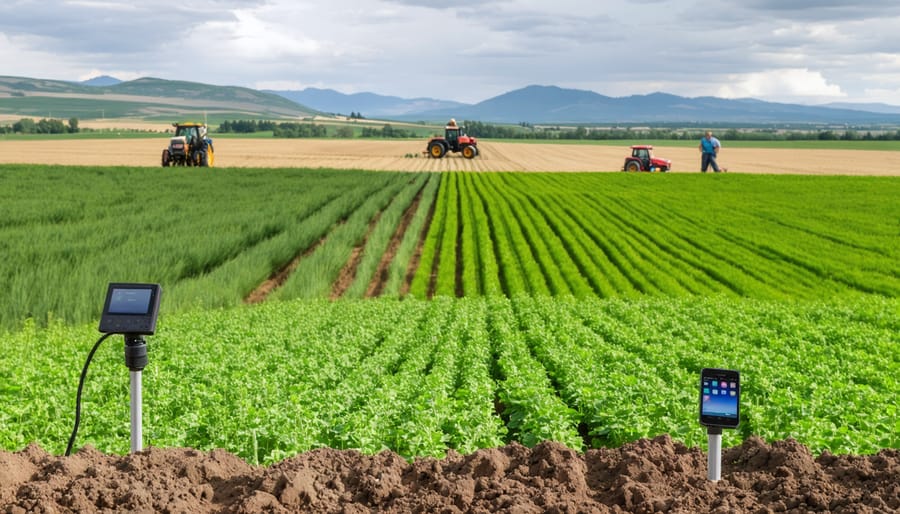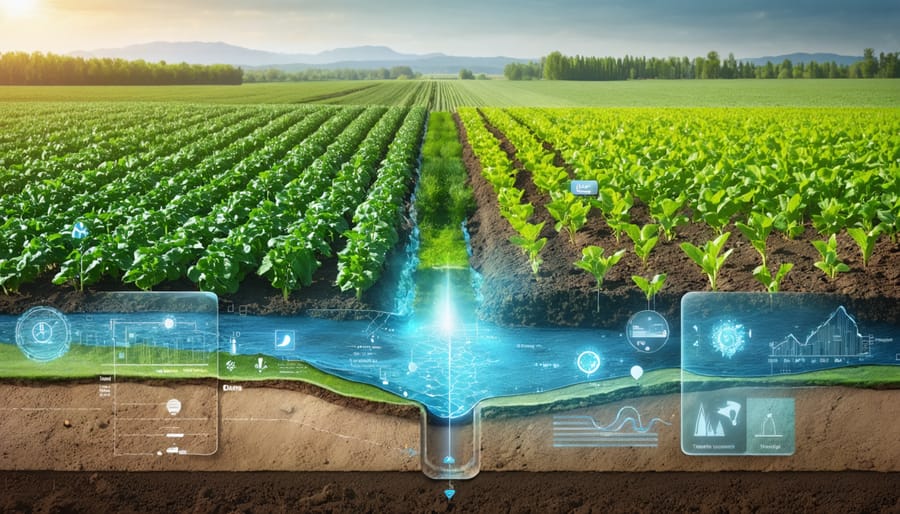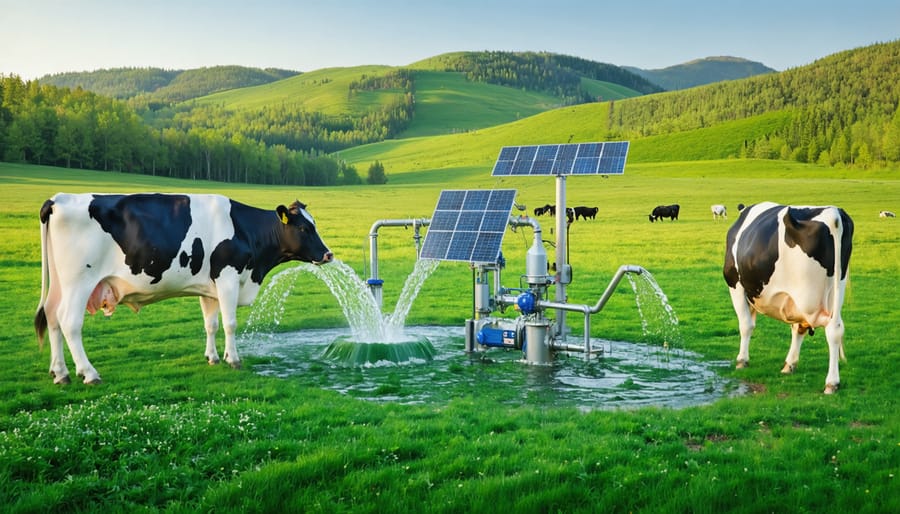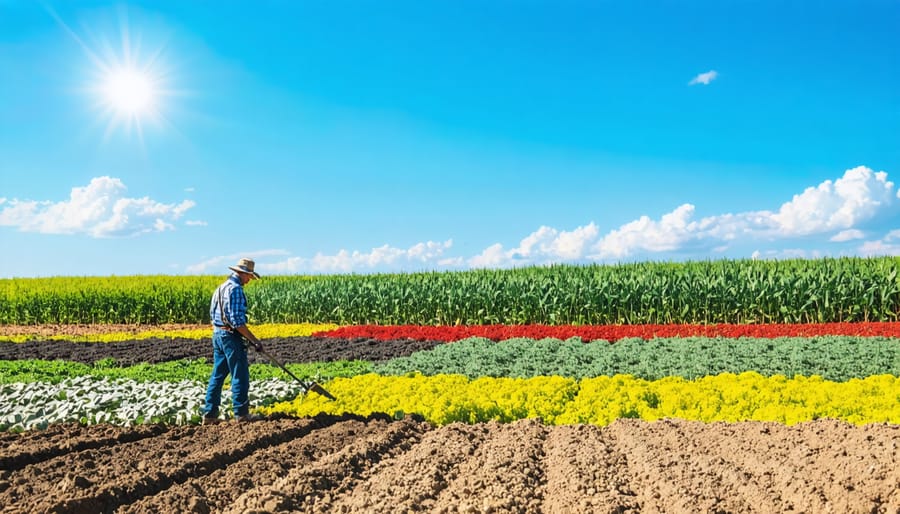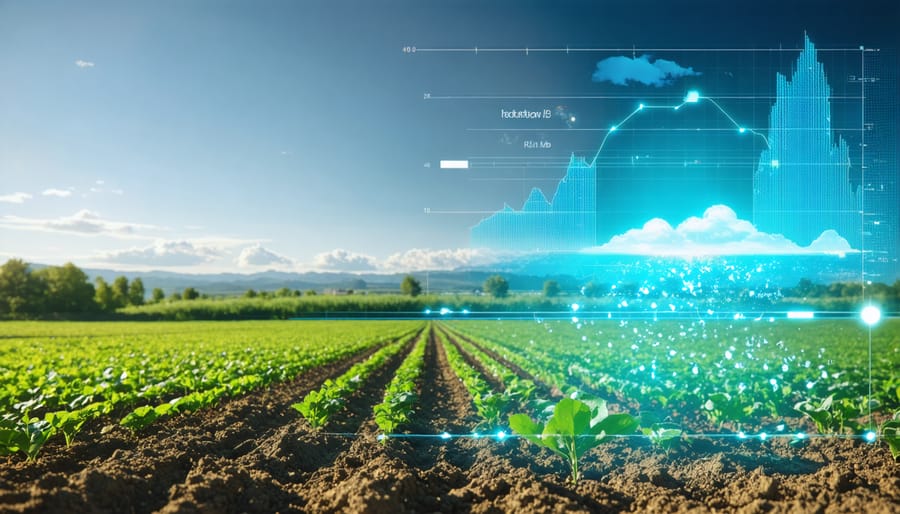Measure soil moisture resistance values weekly during the growing season to optimize irrigation scheduling and prevent yield losses in Alberta’s variable climate. Understanding your field’s r-value soil characteristics unlocks precise soil moisture monitoring capabilities, enabling data-driven decisions that can reduce water usage by up to 30% while maintaining crop health.
R-value measurements serve as your field’s vital signs, revealing critical information about soil density, water retention capacity, and structural stability. For Prairie farmers, these measurements offer particular value during spring thaw and following intense rainfall events, when soil conditions can change rapidly. Recent field trials across central Alberta demonstrate that farmers who regularly track r-values achieve 15-25% better water use efficiency compared to those relying on traditional moisture assessment methods.
Modern soil monitoring technology, combined with understanding r-values, transforms guesswork into precision agriculture. This science-based approach helps you anticipate field conditions, adjust irrigation schedules, and make informed decisions about field operations – all while protecting your soil’s long-term productivity.
Understanding R-Value Soil Measurements
The Science Behind R-Values
The relationship between soil electrical resistance and moisture content follows a predictable scientific pattern that makes R-value measurements a reliable tool for moisture monitoring. When electrical current flows through soil, the resistance varies inversely with the soil’s moisture content – meaning drier soils show higher resistance while wetter soils conduct electricity more readily. This principle allows farmers to use specialized soil testing methods to accurately gauge moisture levels across their fields.
The measurement is particularly effective because water molecules in soil create pathways for electrical flow through their ionic content. As moisture levels decrease, these pathways become disconnected, resulting in higher resistance readings. Temperature also plays a role, with warmer soils typically showing lower resistance values than colder soils at the same moisture content. This relationship helps Alberta farmers make informed decisions about irrigation timing and volume, especially during crucial growing periods when precise moisture management can significantly impact crop yields.

Alberta’s Unique Soil Conditions
Alberta’s agricultural landscape is characterized by diverse soil types, each with distinct r-values that influence moisture management practices. The province’s dominant soil orders include Chernozemic soils in the prairies, with typical r-values ranging from 0.8 to 1.2, and Luvisolic soils in the northern regions, showing r-values between 0.6 and 0.9.
In southern Alberta, clay-rich soils predominate, particularly in areas around Lethbridge and Medicine Hat. These soils typically display higher r-values of 1.0 to 1.4, requiring careful moisture monitoring during both dry and wet periods. Central Alberta’s Black soil zone, stretching from Red Deer to Edmonton, features rich organic matter content and moderate r-values averaging 0.9 to 1.1.
Peace Country farmers work with unique Gray Wooded soils, characterized by lower r-values between 0.5 and 0.8. These variations highlight the importance of understanding your specific soil type and its corresponding r-value for effective moisture management. Local agricultural extension offices maintain detailed soil maps and can provide precise r-value data for your area, helping you make informed decisions about irrigation and crop planning.
Practical Applications in Farm Management
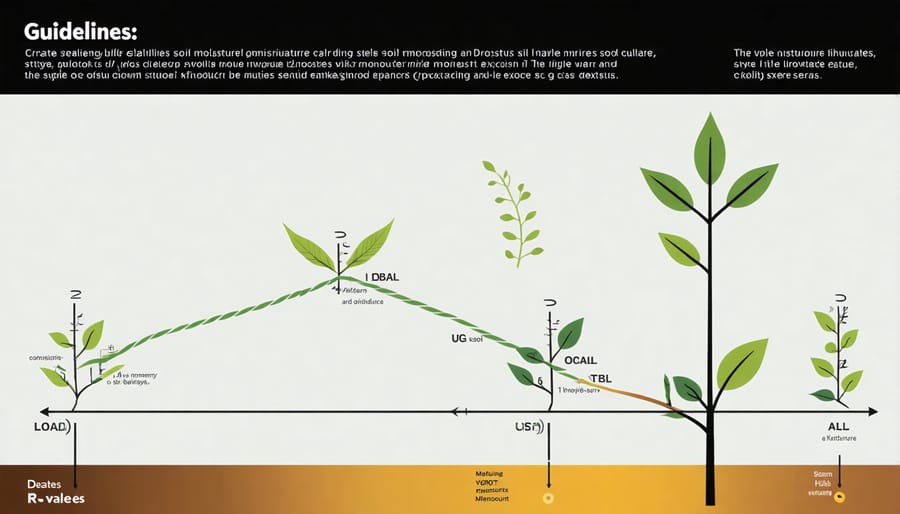
Irrigation Timing and Volume
R-values play a crucial role in helping farmers optimize irrigation schedules by providing precise data about soil moisture retention. For Alberta farmers, timing irrigation based on r-values helps ensure crops receive water when they need it most while preventing waste and potential soil degradation.
The basic principle is straightforward: when soil r-values indicate high moisture retention, irrigation volumes can be reduced. Conversely, lower r-values signal the need for more frequent watering, though with carefully controlled volumes to prevent runoff.
A practical approach is to measure r-values early in the morning before sunrise, when soil moisture is most stable. For most Alberta crops, irrigation should begin when the r-value drops below 75% of field capacity. However, this threshold may vary depending on crop type and growth stage.
As a general guideline, apply water in volumes that bring the soil moisture back to field capacity without exceeding it. For example, if your soil’s r-value indicates it’s at 60% capacity, and you know your soil holds 25mm of water at field capacity, you would need to apply approximately 10mm of water to reach optimal moisture levels.
Many local farmers have found success by combining r-value measurements with weather forecasts to adjust irrigation timing, leading to water savings of 20-30% while maintaining or improving crop yields.
Crop-Specific Considerations
Different crops have varying sensitivities to soil moisture levels, making r-value monitoring particularly valuable for optimizing irrigation scheduling. Root vegetables like potatoes and carrots typically require consistent moisture levels, with r-values maintained between 75-85% for optimal growth. These crops are especially vulnerable to moisture stress during tuber formation.
Cereal crops common in Alberta, such as wheat and barley, show more flexibility in their moisture requirements. They generally perform well with r-values between 65-80%, with critical moisture needs during tillering and grain filling stages. Canola, another major Prairie crop, needs careful moisture management during flowering and pod formation, with ideal r-values ranging from 70-85%.
Pulse crops like peas and lentils demonstrate different moisture sensitivities throughout their growth cycle. These crops prefer slightly drier conditions during early vegetative growth but require consistent moisture during flowering and pod fill, with optimal r-values between 70-80%.
For forage crops such as alfalfa, maintaining appropriate r-values helps balance yield with quality. These deep-rooted perennials can typically tolerate lower r-values, around 60-75%, due to their extensive root systems.
Local producers have found success by adjusting their irrigation schedules based on crop-specific r-value targets, often reporting improved yield quality and more efficient water use. This targeted approach helps farmers maximize their irrigation investment while supporting sustainable water management practices.
Case Study: Success with R-Value Monitoring
In 2019, fourth-generation farmer Mike Jacobson from Drumheller Valley decided to implement r-value monitoring across his 2,500-acre operation. Like many Alberta farmers, Jacobson had struggled with unpredictable spring conditions affecting his seeding decisions.
“We’d been relying on traditional methods and gut feeling,” Jacobson explains. “But with increasing weather variability, we needed a more scientific approach to determine field readiness.”
Working with local soil specialists, Jacobson established a systematic r-value testing program. He divided his land into zones based on soil type and topography, then conducted regular measurements during the critical pre-seeding period. The initial investment included portable testing equipment and staff training, costing approximately $3,500.
The results were remarkable. In spring 2020, while neighboring farms delayed seeding due to uncertainty about soil conditions, Jacobson’s r-value data showed specific fields were ready for equipment traffic. He began seeding canola five days earlier than usual in areas with favorable readings, while avoiding sections that needed more time to dry.
“That early start gave us an enormous advantage,” Jacobson notes. “Our canola emerged before the late May frost hit, and we saw a 15% yield increase compared to previous years.”
The success continued in 2021 when unusually wet conditions challenged many local farmers. Using r-value monitoring, Jacobson could precisely identify which fields could handle equipment without causing compaction. This targeted approach allowed him to begin operations in viable areas while letting wetter sections dry appropriately.
The program’s return on investment has been significant. Beyond yield improvements, Jacobson reports reduced fuel costs from fewer equipment passes and decreased soil compaction issues. He’s now sharing his experience with other farmers through local agricultural associations, helping build a community of knowledge around r-value monitoring in Alberta.
Implementation Guide for Alberta Farmers
Equipment Selection and Setup
Selecting the right equipment for r-value soil monitoring starts with understanding your farm’s specific needs. Essential components include soil moisture probes, data loggers, and automated water monitoring systems that can withstand Alberta’s climate conditions.
For accurate readings, install probes at various depths, typically at 30 cm, 60 cm, and 90 cm intervals. Place sensors in representative areas of your field, considering soil variations and topography. Avoid installing near irrigation lines or areas with unusual drainage patterns, as these can skew readings.
When setting up your monitoring network, ensure proper calibration of all sensors. Most modern systems come with smartphone connectivity, allowing real-time data access. Position your data logger in a protected location with good cellular coverage if using remote monitoring capabilities.
For best results, install equipment during dry conditions when soil is workable. Create precise holes for sensors using proper soil sampling tools to maintain soil structure around the probe. Backfill carefully to ensure good contact between the sensor and soil.
Regular maintenance checks are crucial, particularly before spring planting and after harvest. Keep detailed records of installation locations and depths for future reference and troubleshooting.
Data Interpretation and Decision Making
Making sense of r-value soil data doesn’t have to be complicated. The key is understanding what the numbers tell you about your soil’s moisture retention capabilities. When you receive r-value readings, typically ranging from 0 to 100, higher numbers indicate stronger moisture-holding capacity, while lower numbers suggest faster drainage.
For Alberta farmers, the sweet spot usually falls between 40 and 60, offering a good balance for most crops. However, these numbers shouldn’t be viewed in isolation. Consider them alongside your specific crop needs, local weather patterns, and irrigation schedule.
To put this data to work, start by creating a simple tracking system. Record your soil’s r-values monthly, noting any significant weather events or irrigation changes. This helps you spot patterns and make informed decisions about water management.
When your readings show values below 30, especially during critical growing periods, consider adjusting your irrigation schedule or implementing moisture conservation techniques. Conversely, readings above 70 might signal the need for improved drainage or careful monitoring to prevent waterlogging.
Remember that r-values can vary across your fields. Map these variations to create irrigation zones, allowing for more precise water application where needed. Many Alberta farmers find success by adjusting their practices based on these zones, leading to more efficient water use and healthier crops.
The key is to use r-value data as a guide rather than a strict rule, always considering your local conditions and years of farming experience.
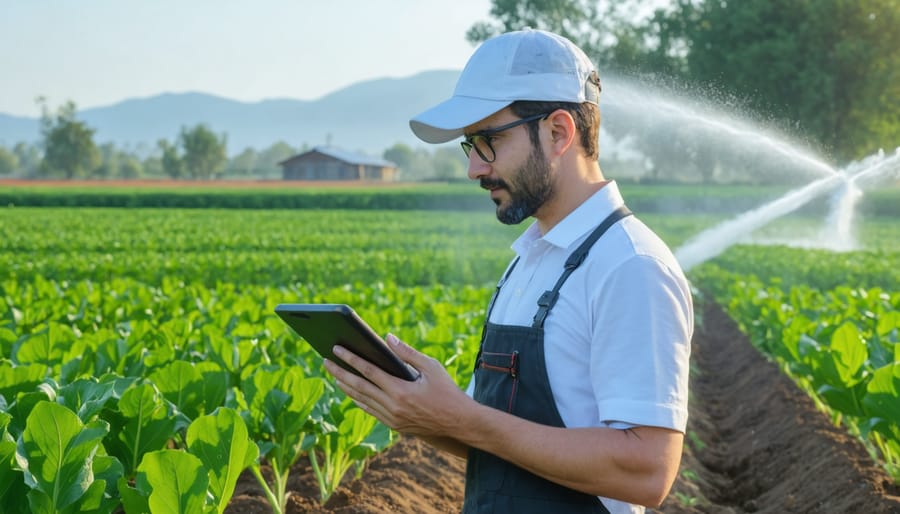
R-value soil monitoring represents a significant step forward in modern agricultural management, offering Alberta farmers a powerful tool for optimizing their operations. By implementing regular r-value measurements, producers can make more informed decisions about field operations, potentially saving thousands of dollars in equipment maintenance and fuel costs while protecting their valuable soil resources.
The benefits extend beyond immediate operational efficiency. Farmers who have adopted r-value monitoring report improved crop emergence rates, better soil structure maintenance, and more effective moisture management throughout the growing season. These advantages translate into tangible economic benefits while supporting sustainable farming practices that will serve future generations.
As our climate continues to change and weather patterns become less predictable, having reliable soil monitoring tools becomes increasingly crucial. The r-value system provides that reliability, offering a standardized approach that works across different soil types and farming operations throughout Alberta.
We encourage all producers to consider incorporating r-value monitoring into their regular field management practices. Local agricultural extension offices and soil conservation groups offer training and support for implementing these systems. By working together and sharing experiences, our farming community can continue to advance sustainable soil management practices while maintaining profitable operations.
Remember, healthy soils are the foundation of successful farming, and r-value monitoring is one more tool in our collective toolkit for achieving that goal.

